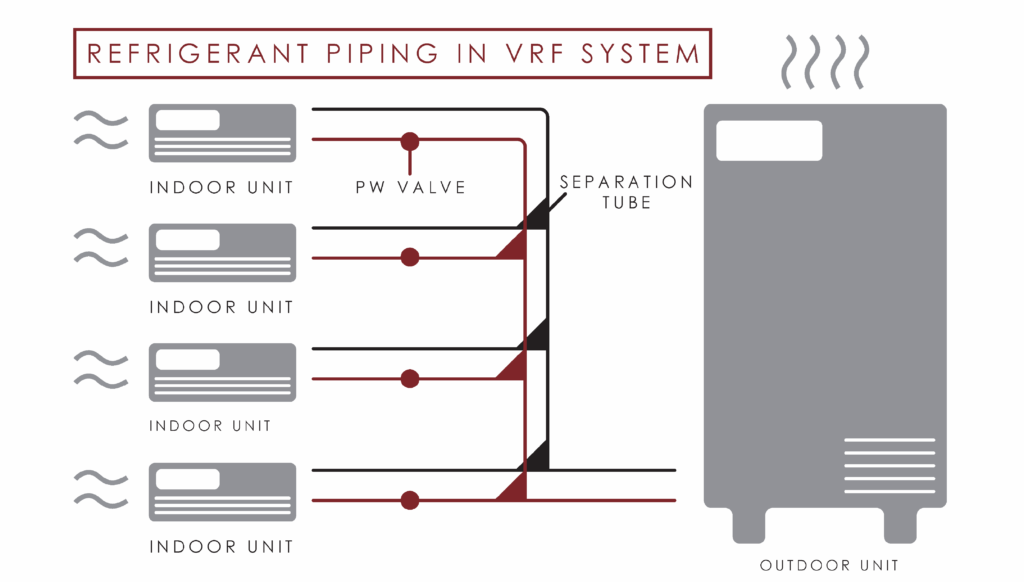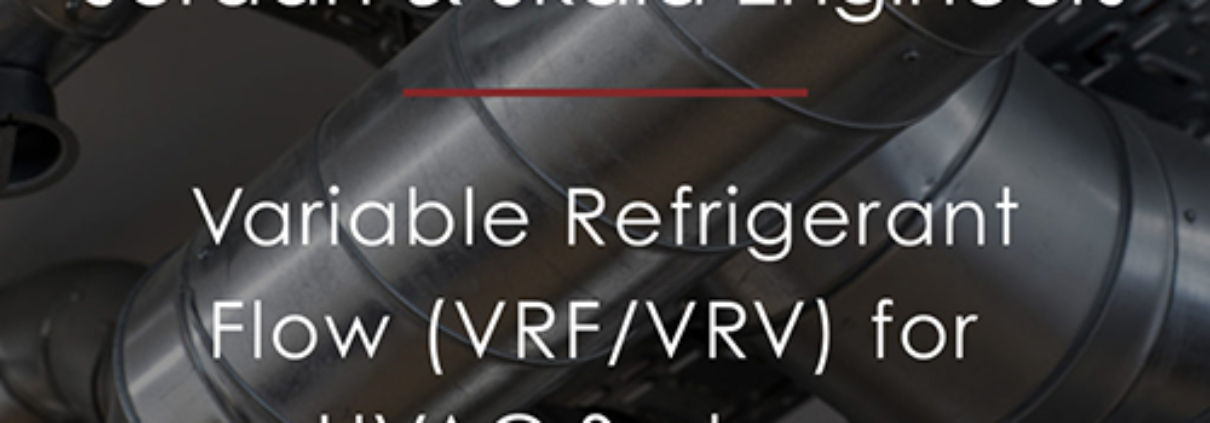Variable Refrigerant Flow (VRF/VRV) for HVAC Systems
While a conventional direct expansion (DX) split system AC is simple to install, operate, and repair with thermostat controls, low initial costs, and individual metering, the system has evolved. Conventional DX split systems are sized to meet maximum heating and cooling loads, lack redundancy, and have multiple compressors to maintain; however, advancements in air conditioning technology have resulted in Variable Refrigerant Flow (VRF/VRV) systems, giving developers and owners an option for greater efficiency and sustainability in heating and air conditioning.
What are VRV/VRF systems?

VRV was first invented in Japan in 1982 by Daikin, an HVAC product manufacturer. Since the invention of the system, there are now many different manufacturers of this system. Variable Refrigerant Volume (VRV) and Variable Refrigerant Flow (VRF) are two terms for the same system. Because VRV is a trademark of Daikin Industries, Daikin uses the term VRV and all other manufacturers use the term VRF or Variable Refrigerant Flow. VRF/VRV systems consist of a single outdoor heat pump connected by refrigerant piping to multiple indoor units. The basic function of HVAC systems is to transfer and move energy for the purpose of heating and cooling interior spaces. Different mediums can be used to transport heat energy, including air, water and refrigerant. VRF/VRV systems use refrigerant to move heat energy to where it’s needed. Refrigerant is one of the most efficient mediums for transferring energy, in terms of energy (watts) per mass (kilogram). The term variable as it applies to VRF/VRV systems means that VRF/VRV systems vary the amount of refrigerant being circulated through the system, delivering only the amount of refrigerant needed at any one time. Because VRF/V systems use the most efficient means for transporting energy (refrigerant) coupled with variable speed technology that greatly reduces energy use, VRV/F systems are highly efficient and sustainable systems.
What are VRF/VRV systems’ best applications?

“Work/life balance” VRF/VRV systems are best suited where there is a need or preference for energy efficiency and many individual zones. VRV/F systems are frequently used in multifamily buildings, student housing, assisted living, classroom buildings, hotels, smaller office buildings, and some retail. Though less common, VRF/VRV systems can also be used in mid-rise office buildings. Because they use inverter compressors, VRF/VRV systems can provide adequate heating in most climate zones even when the temperature is near 0 degrees Fahrenheit.
What are the advantages of VRF/VRV systems?
Refrigerant heat transfer has 20 times more transfer capability than chilled water and 190 times more transfer capability than air alone. With refrigerant, the greatest amount of energy per mass is transported, resulting in greater energy efficiency and stability. Owners and developers alike are increasingly choosing VRV/VRF systems for their attractive lifecycle cost, energy efficiency, user comfort, and flexibility.
What are the pros and cons of VRF/VRV systems?
Pros
(1) VRF/VRV systems are very highly energy efficient.
(2) Multiple indoor air handlers connect to a single condensing unit, which can throttle down to meet the load, saving more energy than traditional systems.
- In multi-tenant buildings where one VRF/V system may serve multiple tenants, the VRF/V systems have the ability to allocate energy usage between the different tenants for billing purposes.
(3) More thermostat controls, an optional “dry mode” for dehumidification, and lower noise levels make VRF/VRV systems especially appealing.
- More thermostat zones means more control.
(4) VRF/VRV systems use inverter compressors, so they can provide adequate heating in most climate zones even when the temperature is near 0 degrees Fahrenheit. This means that a VRF/VRV system does not require an auxiliary electric heating coil in some climate zones
(5) Compared to DX split systems, these systems require less outdoor equipment (smaller footprint), fewer compressors to maintain, and fewer Mechanical and Electrical connections.
- VRF/V condensing unit locations are very flexible. They can be installed above and below the indoor equipment (within manufacturer-specific guidelines), they are capable of very long line lengths allowing the condensing units to be located quite a distance away from the indoor units and they can even be mounted indoors. When mounting indoors, they have to be located next to an exterior wall with discharge air ducted to the outdoors, but this feature allows many advantages in high-rise buildings, urban retail, and other locations where concealed installation might be advantageous.
- When comparing VRF/VRV to DX systems in multi-family buildings, the VRF/V condensing units can utilize higher voltage power than DX split systems, resulting in smaller electrical distribution equipment and feeders reducing electrical first cost.
Cons
(1) The initial cost is higher than DX split systems, similar to water source heat pump systems (WSHPs), and lower than 4-pipe chilled water/hot water systems.
- VRF/V systems typically require a separate dedicated outside air system (DOAS) to bring outside air for ventilation into a building.
- Because these systems are newer and specialized, some contractors may lack experience installing VRF/VRV systems.
- Refrigerant monitors and associated controls for automatic shutoff may be required in some applications, which could present an additional expense.
- While international manufacturers in Japan, China, and throughout Europe have been quick to adopt technological advancement in air conditioning systems and have ramped-up their production to capacity, only 3-5% of all new construction in the United States currently uses VRV/VRF technology. The relative lag has led to less familiarity with the system among US-based developers and contractors, leaving greater room for error during installation.
- While traditional split system heat pump systems hold their position as the least expensive option for multifamily projects, a VRF/VRV system can incur the same construction cost as split system heat pumps depending on any rebates offered by the state and/or local utility company.
(2) System controls are also proprietary, locking users into the technology and requiring the installed manufacturer to repair.
- The design of the refrigerant piping system is unique to each specific manufacturer. Once a specific manufacturer’s system and equipment are installed in a building, that same manufacturer’s equipment must be used for the life of the building.
(3) VRF/VRV systems also increase coordination demands during design and in the field to navigate pipe routing.
(4) Additionally, exposure to refrigerant can be a health and safety risk. Leaks can occur over time and must be monitored and repaired.
(5) As VRF/VRV is a newer technology in the United States, there is confusion about how the systems work and their proper application.
- Tightened specification requirements for VRV/VRF systems include confirming that manufacturers have been in business for 10 years, requesting their credentials, vetting them, and documenting progress.
- Improper installation can hinder equipment startup.
- Technologically experienced partners are necessary to sift through the confusion surrounding the quantity of VRF/VRV products in the marketplace, how the systems work, and their proper application. The MEP and design professionals at Jordan & Skala are skilled at navigating diverse markets and identifying ideal systems, such as VRF/VRV, that support a project’s long-term success. Proper implementation of VRF/VRV by knowledgeable partners results in reliable, modernized, and sustainable builds.
What are some of the industry trends, in terms of high-rise multifamily developments?
As more US-based manufacturers adopt VRF/VRV technology, supply is increasing along with local contractor expertise. Lowered costs from increased supply are resulting in greater system familiarity and experience. Some building owners are experimenting with VRF/VRV systems for Class A speculative office buildings.
A water-cooled variant of VRV/VRF allows taller buildings to capitalize on energy efficiency by situating condensing units in rooms on the occupied floors. VRV/VRF use in hotels is growing. Contractors are becoming more comfortable with installation, leading to fewer errors during the process. Developers are familiarizing themselves with the technology and its applications. The lower lifecycle cost and decreased energy consumption of VRV/VRF systems have helped developers see past initial expenses. Projects earn LEED points for using VRV/VRF technology for energy efficiency. The Army Corps of Engineers has even implemented VRV/VRF technology for its lifecycle cost, flexibility, and especially its smaller space requirements.
Closing
If your goals for your next multi-family development include greater efficiency, sustainability, and flexibility, including a VRV/VRF system provides both efficient energy use and decreased lifecycle costs from the refrigerant transport capabilities. As these systems become more prevalent in the United States, confirm that your potential construction partners are technologically experienced. The MEP engineers at Jordan & Skala pay close attention to industry shifts and are experienced with adapting to new technology to produce modernized, viable developments. Technologized construction partners can help prioritize your development’s long-term success and sustainability, especially with emerging VRV/VRF systems.
Download Guide
Learn more about Variable Refrigerant Flow (VRF/VRV) for HVAC Systems by downloading our guide.












Leave a Reply
Want to join the discussion?Feel free to contribute!